There’s the tsunami of AI-generated content that Google is struggling to filter out, so now you have to compete.
There are the chatbots that people are starting to use to search instead of Google.
There are shrinking budgets (for marketing and for buying software).
Sales cycles are longer.
Head count is smaller.
Attribution is the wild wild west.
When it comes to search engine optimization (SEO), especially for B2B, the way forward has become blurry and intimidating.
In this guide, I’m covering B2B SEO best practices, but also new ways to ensure your B2B SEO strategy aligns with the future of search and buying behavior.
What is B2B SEO?
Business-to-business (B2B) SEO is the strategy behind getting your business’s website noticed by other businesses on search engines. It’s not about appealing to everyday consumers, but targeting companies that could be interested in what you’re offering. The aim is to increase the right kind of traffic to your site, and eventually converting that traffic into paying customers.
In practice, B2B SEO means two things:
- Optimizing your website so that when people are searching for products or services like yours, they find you
- Creating content that addresses the questions and pain points your buyers go through.
Because business buyers do thorough research, your site needs to have content that’s not just promotional but genuinely useful, answering their questions and showcasing your expertise.
Keywords in B2B SEO are usually more specific and industry-related, targeting the exact terms business searchers are using. The goal is to make your site a go-to resource, so when they’re ready to make a decision, you’re at the top of their list.
To sum it up, B2B SEO is about attracting business traffic to your site and convincing them you’re the right choice through strategic content and optimization. It’s a way to stand out to potential business clients in the vast online world.
Related Post: 6 B2B Content Marketing Agencies That Simply “Get It”
B2B SEO vs B2C SEO
Technically, SEO works the same for both B2B and B2C.
Google does not change its algorithm based on who you’re trying to reach.
SEO best practices work in both B2C and B2B.
But there are some critical differences between B2B SEO and B2C SEO.
1. Low-volume keywords
B2B SEO tends to have lower volume than B2C.
So if you come from B2C and are used to receiving thousands of visits per page, expect that number to go down to double digits.
There are simply fewer specific B2B buyers than there are of a general consumer public.
For example, your pool of Heads of People from companies that specifically integrate with your partners and have at least 250+ employees is a fraction of your pool of men who want to shave.
What we call “bottom-funnel” keywords, or keywords that have a clear purchasing intent, can often have only 10-40 searches a month if you’re lucky.
Especially if you work in a niche vertical and your committed to only targeting your buyers, traffic will be overall much lower for a B2B website than a B2C website.
2. B2B and B2C SEO have different goals
The goals of a B2B SEO campaign are often to raise awareness, generate leads that convert into sales in the long term, and engage the audience throughout the complex decision-making process.
B2B buying involves decision-making committees with multiple stakeholders. B2B buyers use organic search to stack up vendors. But, they also check with peers, and it helps if they’ve seen your content long before they reach the decision-making stage.
On the other hand, B2C SEO aims to drive immediate, impulsive purchases from visitors to the website. This also means the conversion rates are different: B2B websites, on average, have a conversion rate of around 1%, where B2C websites is usually double or more.
3. B2B SEO is more editorial-heavy
Because B2B buying is far from impulsive, it’s not enough to optimize product pages and run a programmatic SEO campaign like it might be for B2C.
Content creation is a major part of SEO: working with your internal subject-matter experts, creating hyper-helpful content with insights from practitioners, and answering buyer questions better than anyone else on the internet.
B2B SEO in 2024
SEO has changed more in 2023 than it did in the last 10 years of existence. That’s why I had to write a completely new guide to B2B SEO.
In one year, we had:
- ChatGPT and other generative AI completely overhaul the world of content creation.
- People using AI as search engines, and search behavior radically changing for the first time since Google began.
- Google’s experimentation (and threat of launching) SGE, severally affecting search traffic forecasts.
- Google had 5 more algorithm updates in 2023 than it had any year prior.
- Google announced they’re getting rid of 3rd-party cookies by the end of this year.
In March 2024, Google made the Helpful Content Update a part of their core ranking algorithm.
The timing is good, since SEOs and companies abound were abusing AI to generate thousands of pages a month. The rest of us, following what Google told us to do and “creating helpful content”, watched as garbage created in mere minutes outranked pieces we spent thousands of dollars and 40+ hours creating.
They promised a 40% reduction of spammy and unhelpful content—and we’ve already seen some websites wiped off the face of the internet.
At the time of writing this, we’re still halfway through the update and we have yet to see if the promises Google is making will be realized. In any case, the algorithm is moving toward making content more helpful.
What does this all mean for your marketing efforts in B2B SEO?
DOs
- Do integrate AI technology into your content creation process to stay competitive and innovative, but ensure it’s used to enhance the quality rather than just pump out volume.
- Do involve subject matter experts (SMEs) in your content creation to add depth, accuracy, and valuable insights that AI alone cannot provide.
- Do focus on creating genuinely helpful and valuable content that addresses specific needs and questions of your target audience.
- Do focus on creating a great user experience rather than focusing on adapting to each new algorithm change—they’re all heading in the same direction.
- Do audit your content regularly to ensure it meets the new standards for helpfulness and quality, and revise or remove content that doesn’t contribute value.
- Do invest in understanding your audience’s changing search behaviors, particularly with the rise of AI as a search tool.
- Do optimize for user experience (UX), ensuring your site is easy to navigate and content is easy to consume.
- Do leverage AI for data analysis and insight generation to inform your SEO and content strategies more effectively.
- Do focus on building E-E-A-T (Experience, Expertise, Authoritativeness, Trustworthiness) with high-quality backlinks, digital PR, first-hand experience, proper citations, and showcasing your expertise.
DON’Ts
- Don’t rely solely on AI for content creation without human oversight, enhancement and value add.
- Don’t ignore the importance of original research and unique insights in your content, which can differentiate you from the slew of garbage online.
- Don’t overlook the potential penalties for spammy or manipulative content practices, like buying links or generating all of your content with AI alone.
- Don’t neglect the user’s search intent, which is becoming increasingly complex with the introduction of AI search behaviors.
- Don’t spam keywords or over-optimize content in a way that detracts from the natural flow and usefulness of the information.
- Don’t disregard the importance of technical SEO, including site speed, mobile optimization, and structured data, which are foundational to your site’s success—but don’t overfocus on this either. Remember, the end goal is a good user experience.
- Don’t stick rigidly to single tactics without considering the dynamic nature of SEO, how it ties into other digital marketing channels like demand gen and thought leadership, and that it is about creating a holistic experience.
- Don’t forget to diversify your content formats (videos, podcasts, infographics) to cater to different preferences and enhance engagement.
Example of a winning B2B SEO strategies
B2B SEO has single-handedly driven millions in revenue for companies who have invested in it.
And that revenue doesn’t have those millions of dollars in ad spend cutting into its margin, since the majority of traffic was acquired organically.
Here are a couple examples of B2B companies who have approached SEO strategically:
TravelPerk
TravelPerk, which closed $100M in a Series D-1 in 2024, now valued at $1.4 billion, has a healthy growth mix of outbound, paid and SEO. According to Similar Web, about 30% of their traffic comes from organic search.
They have over 200k monthly visits and are continuously growing organically. So what did they do right?
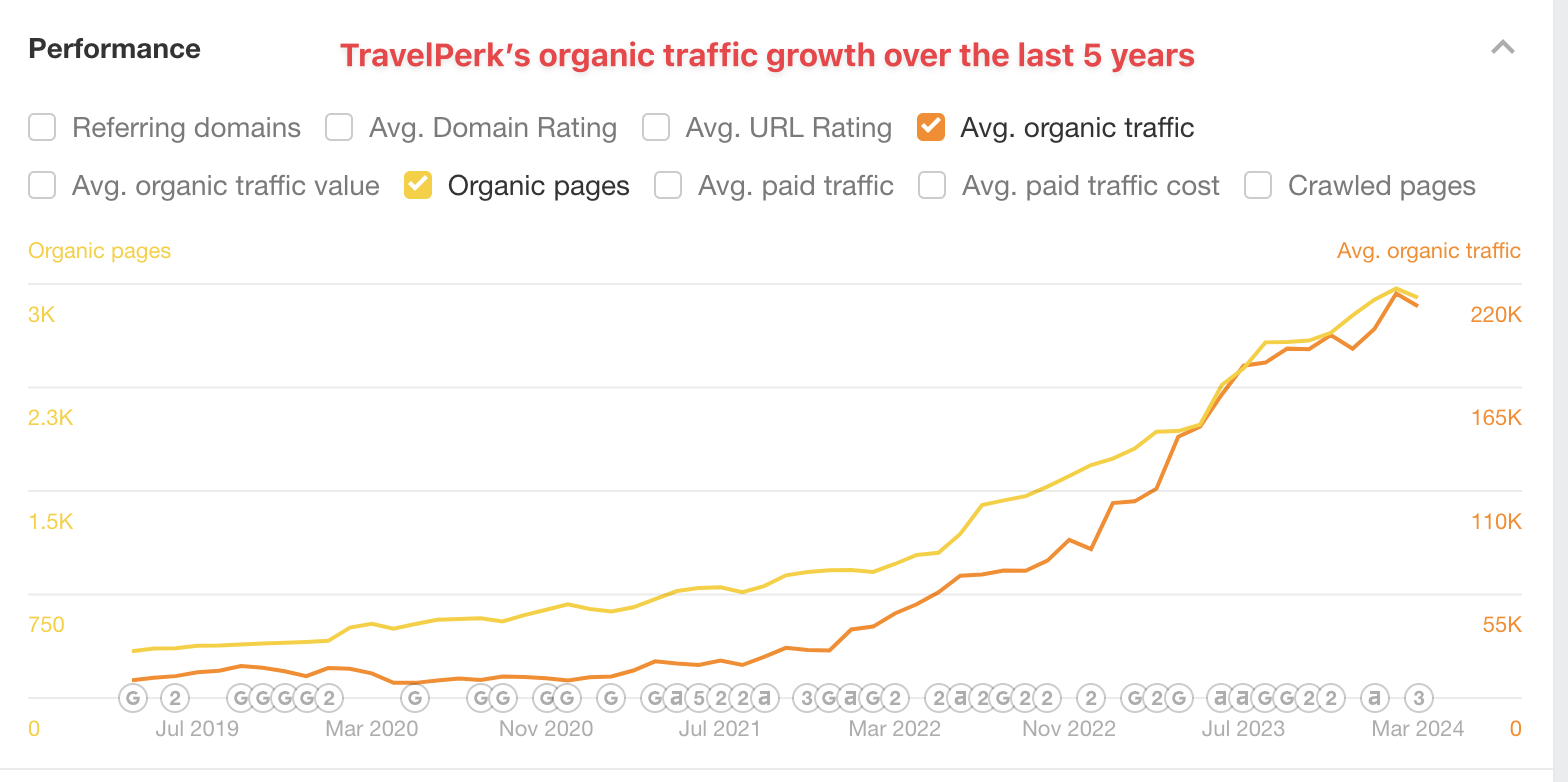

TravelPerk uses topic clusters and creates content for the entire funnel. As a business travel expense management tool, one money keyword is “business travel expenses”.
To build topical relevance around that keyword, they built a guide (topic cluster) that covered multiple aspects around business travel expenses.
The main topic, “business travel expenses” is broken down into 8 sub-topics (each a child page to the parent page “business travel expenses”) and they each get broken down further. Each child page links back to the parent page to build a hierarchy of interlinks.
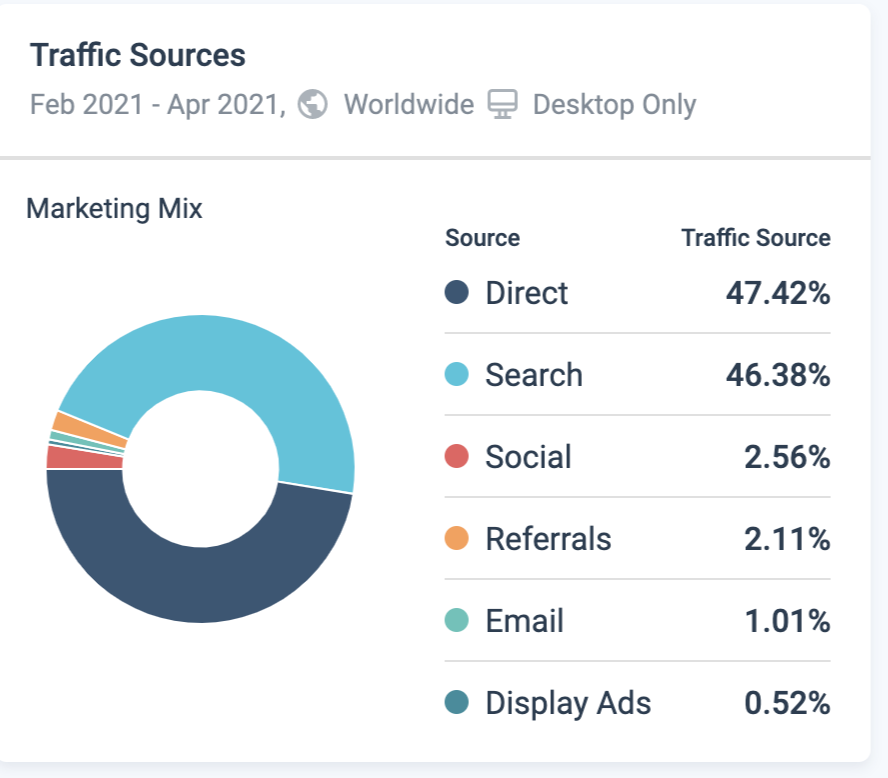

They repeat this process for each main topic they want to drive traffic to. Each topic that qualifies readers as prospects gets its own cluster (guide), for example:
- Corporate travel safety
- Small business travel
- Corporate travel policies
- Corporate mileage reimbursement
- Corporate travel management
And the list goes on. There are in total 11 parent categories (for their guides), each with 2-8 child pages.
But they don’t only focus on money keywords, they also have a robust top-funnel content strategy, with content strategies like:
- Building a corporate travel glossary (low-intent content used for building topical relevance)
- Business travel statistics pages (for building links and capturing TOFU traffic)
- Other travel-related TOFU content like overcoming jetlag and car rental companies for business travelers
This mixed approach to SEO means they can:
- Build topical relevance around business travel
- Capture traffic before they’re ready to buy
- Rank faster for money keywords
Now, let’s dive into in-depth SEO strategies you can use for your B2B company.
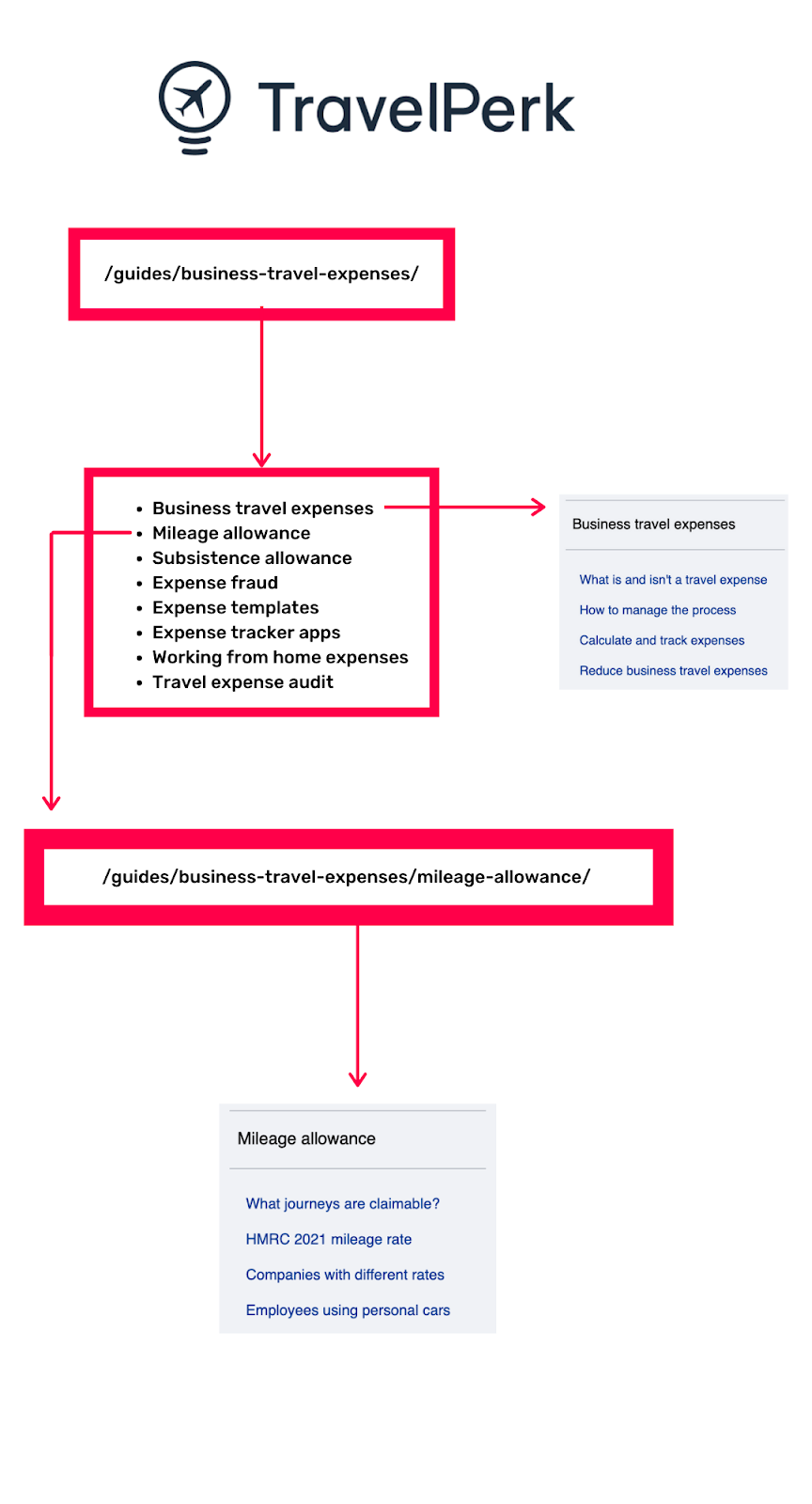

B2B SEO best practices for 2024
Things have changed, but many post-Penguin SEO best practices still stand.
It’s always been the case to:
- Create a high volume of great quality content that is strictly written for your potential customers
- Build great links from relevant websites (guest posting works if you can find a great partner and still create great content for them)
- Do high quality digital PR and off-page SEO
- Internally link your pages strategically
- Make your page fast, accessible, and easy to navigate
- Keep an ongoing schedule to reoptimize your pages long after you’ve published them
- Build topical authority by covering the full funnel
- Don’t keyword stuff, instead write comprehensive articles covering the whole topic
Some SEO “best practices” we can say goodbye to in the new era:
- The Skyscraper Technique—instead of trying to just make your article longer than what’s ranking, add more value, add more experential insights.
- Creating pages for every single keyword variant
- Focusing 100% on content velocity and ignoring relevance and quality
- Creating exact-match domains
- Over-optimizing internal link anchor texts
These remain the same, and from the little data surrounding the topic of optimizing for LLMs, these practices also transfer over. New things that are more important to prioritize in your SEO practice are:
- Add more rich media—video and audio content should now be a part of your SEO content strategy
- Focus on ethical use of AI-powered content creation for your SEO efforts
- Prioritize adding first-hand experience, subject-matter expert insights, authentic and uncurated graphics
- Add author pages with detailed biographies, with a focus on their experience on the subject at hand
- Add “verified by” people who are experts in the topic of the piece of content
- Building a strategy based on topics rather than keywords
Create your own B2B SEO strategy
Your B2B SEO strategy will heavily depend on your own industry, product, and audience.
It will also depend on where SEO sits in your org—is it responsible for lead generation or demand generation?
Is it expected to be a revenue driver or an audience builder?
These are all questions to ask yourself, but I hope this strategy is universal enough for you to take and adapt on your own.
1. Understand the B2B decision maker or the Job-To-Be-Done
If you’ve ever read one of our content strategy case studies, you’ll see that we don’t start keyword research or a competitor analysis until we’ve done a full and deep analysis of the buyer.
In B2B, it’s important to understand the process your customers have gone through before they decided to work with you. That way, you’ll be able to help self-qualify as prospects, convert to leads and turn into loyal customers.
A buyer persona is far more than a list of demographics and firmographics. You do need those two for B2B SEO content. But what really moves the needle is their daily frustrations and goals. A B2B buyers needs encompass them as a human and them in their role at work.
That’s why the first step to a B2B SEO strategy is customer interviews or surveys.
Interviews are better, if you can. Most of the time, busy people will give short responses to surveys. The data is more valuable on a call—you can use their exact verbiage in your content.
Ask them the following questions:


Document all your answers. This will help:
- Understand what content is helpful or not helpful to them
- Build style guides to provide to writers on your ICP’s pain points & challenges
B2B decision-makers are busy and bombarded daily with sales information and content.
The only way to stand out is to ensure your content speaks to their real situation.
This process not only prevents you from guessing wrong (which a lot of companies end up doing), but it also provides you with the exact way B2B decision-makers decided to use your product. It provides you with the top-, mid- and bottom-funnel mindset for you to build your content from.
Speaking of the funnel, the next step in the strategy is to find your bottom-of-the-funnel keywords.
Key takeaways:
- Start with in-depth customer interviews to capture the language and pain points of your target audience.
- Document the decision-making process of your buyers to inform your content and keyword strategy.
- Utilize buyer persona insights to guide the creation of content that addresses both human and role-specific needs.
2. Do bottom-of-the-funnel B2B keyword research
By the time you get to this step, you’ll already have a lot of bottom-of-the-funnel keywords to check for: your customers would have told them to you themselves.
BOFU keywords are those people use when they’re ready to buy what you sell.
These generally have modifiers that include “provider”, “solution”, “software”, or “platform”. These also include competitor comparison pages like “vs” and “alternatives”.
While a good B2B SEO strategy will have a holistic approach, targeting keywords from every part of the funnel, it’s important that you have these demand-capturing pages in place.
For example, looking at TravelPerk in our example above, their bottom-of-the-funnel keyword would be “corporate travel management software”. So, they created a page that was optimized around that keyword:
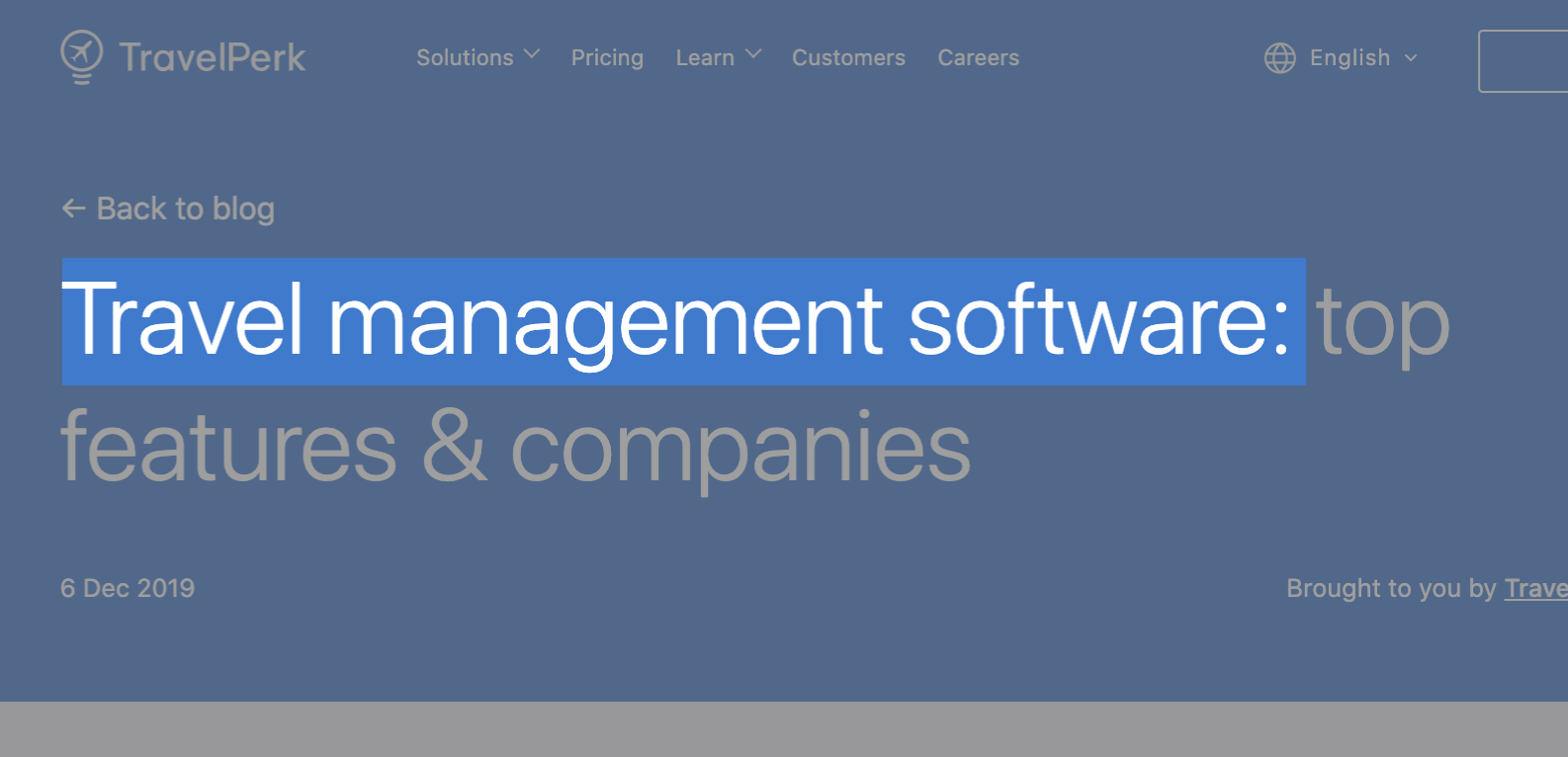

There are a few ways to do your BOFU keyword research.
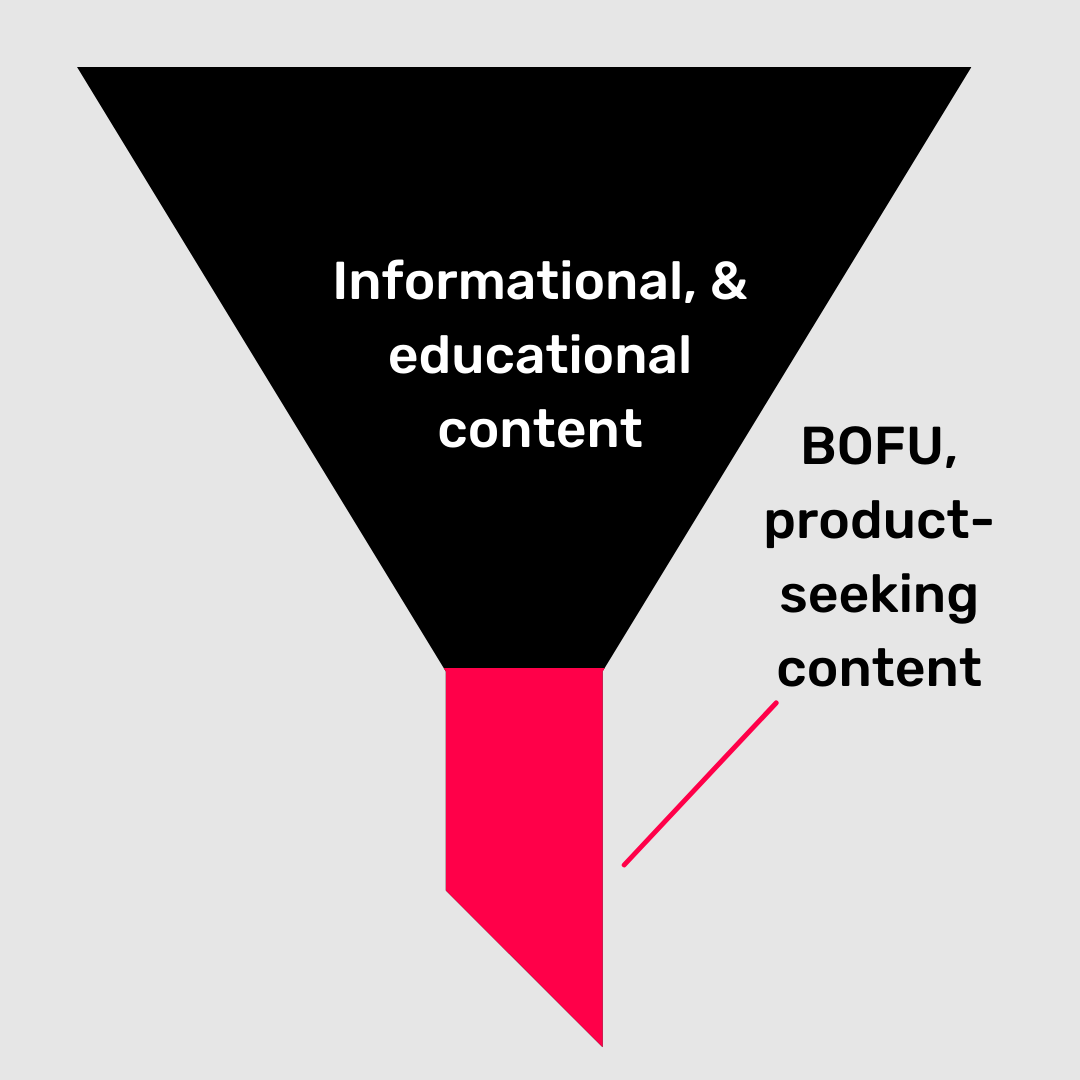

Use your findings from step 1
First, go through your customer interviews. Take the words they used to describe your tool and check it in your keyword research tools.
Use a tool like Otter.ai to record your interviews with them and get transcripts. It’ll automatically provide you with the main keywords that were frequently used, and you can also scroll through and pick up what’s interesting.
Using your customer’s words as BOFU keywords is a creative way to find keywords your competitors haven’t thought of using yet.
Search for your brand name and competitor brand names in online communities
Type in your brand name or competitor brand name in the search function on Slack groups where your audience spends time.
Often, you’ll see them appear as a response to a question where somebody describes the software or solution they’re looking for.
This gives you more insight into how people perceive and describe your and your competitors’ products.
Check Google Search Console for search queries with BOFU modifiers
Go into GSC and filter out for queries that include the modifiers that show intent for your product. You’ll find relevant keywords that people have actually used to try to find your solution, and you can optimize for those.
Don’t only focus on high-volume keywords
For B2B, most of the real money keywords will have low volume.
And search volume tools are inconsistent and inaccurate for the most part. Don’t focus so much on search volume such that you ignore keywords that seem interesting just because they only have a handful of searches per month.
There are 4.6 billion internet users today. We search for weird stuff. The majority of searches are long and weirdly specific.
For example, take a look at this keyword:
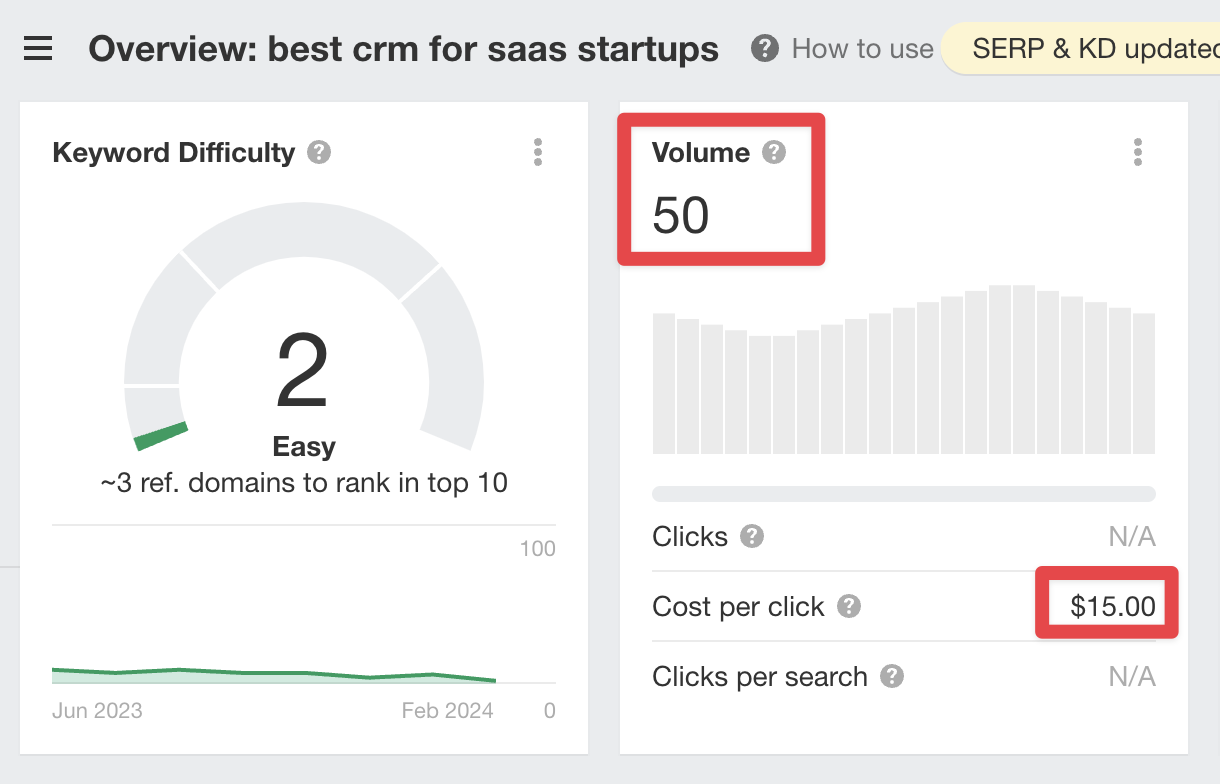

“Best CRM for saas startups” only has 50 searches per month. Why would you put so much effort into ranking for it?
On the other hand, it has a CPC of $15. Your competitors are paying $15 just for someone to click this on this ad—and you could easily rank it for free. This is the long-tail gold you should be looking for.
Key takeaways:
- Focus on keywords that indicate a readiness to purchase, such as those including “solution,” “provider,” and “software.”
- Extract BOFU keywords from customer interviews and use them to guide your content creation.
- Don’t overlook low-volume keywords; they can be goldmines for targeting niche, ready-to-buy audiences.
3. Optimizing your features or services pages
Now that you have your list of bottom-of-the-funnel B2B keywords, it’s time to check whether your feature or services pages are optimized for your money keywords before you start creating new content.
If you don’t have a page built for every separate feature, start there.
The BOFU keywords you found in the last step are what should be considered your “foundational SEO”. That’s what you should be doing here.
Don’t lump all your features or services onto one “solutions” page—each should have a separate page optimized for their own keyword.
Build one page for each feature, and link to them both in the menu and in the footer.
Then, when you start creating more content, remember to keep linking to your feature pages to build topical relevance and help you rank for those keywords.
Key takeaways:
- Ensure each feature or service has its own dedicated page optimized for relevant BOFU keywords.
- Structure these pages to directly address the needs and questions of potential buyers.
- Use strategic internal linking to boost the SEO performance of these crucial BOFU pages.
4. Do long-term B2B keyword research
You don’t need to exhaust all of your bottom-funnel before you start building pages higher in the funnel.
Generally you’ll want to support your money pages with other topical pages that are higher in the funnel. They won’t convert as well, but you need them because:
- Your money pages need topically relevant internal links
- Buyers are more likely to convert when they have already read other content that isn’t bottom-funnel
Your keyword research should focus on:
- Building topical relevance
- Identifying search intent
- Building a portfolio of content from all parts of the funnel
Remember, SEO for B2B should be holistic and you shouldn’t focus only on bottom-of-the-funnel pieces. You also need visibility, buyer enablement, and to bring more traffic into your funnel.
Building topical relevance
Do you ever wonder why B2B companies would ever invest in “glossary” content when there’s nothing to suggest it’ll convert to customers or bring a lot of traffic?
Or why you’d write about something that’s not directly related to your product, or cover some kind of feature that your product doesn’t have?
A huge mistake most B2B companies make is only writing content that’s directly related to what they sell.
Not only does that get boring and dry up fast, but only product-related content doesn’t build brand or increase traffic.
The reason is that Google ranks websites that are topically relevant at the site level. They won’t rank your single blog post, no matter how well-optimized it is or how many links you have pointing to it, if you don’t regularly write about that topic.
If you produce a high volume of well-optimized and well-written articles around a single topic, metrics like your competitors’ domain authority will become less relevant when ranking.
Identifying search intent
When choosing your keyword, be sure to look at more than search volume and CPC.
Search intent is critical to SEO.
Sometimes, a keyword you think is great turns out to have nothing to do with what you thought.
For example, if you wanted to rank for “community engagement”, thinking you’re writing about social media communities, online communities and marketing, you’d quickly discover that people searching for community engagement are more interested in social movements and community welfare.
Make sure you understand the intent for all the keywods you choose to rank for.
Key takeaways:
- Expand your keyword research beyond immediate conversion to include top and middle of the funnel keywords.
- Aim to build topical authority by covering a wide range of subjects related to your main product or service.
- Ensure you understand and match the search intent of your target audience with your content.
5. Build topic clusters for your B2B blog
As you build out your topical relevance, remember to connect and organize it all into topic clusters or content silos.
You’ll find that certain kinds of content can be grouped together: your broader topics can be broken down into sub-topics, just like you saw in the TravelPerk example above.
All your child pages should link back to your main page of the topic cluster, the “pillar page”. In some cases, that can be your main feature page.
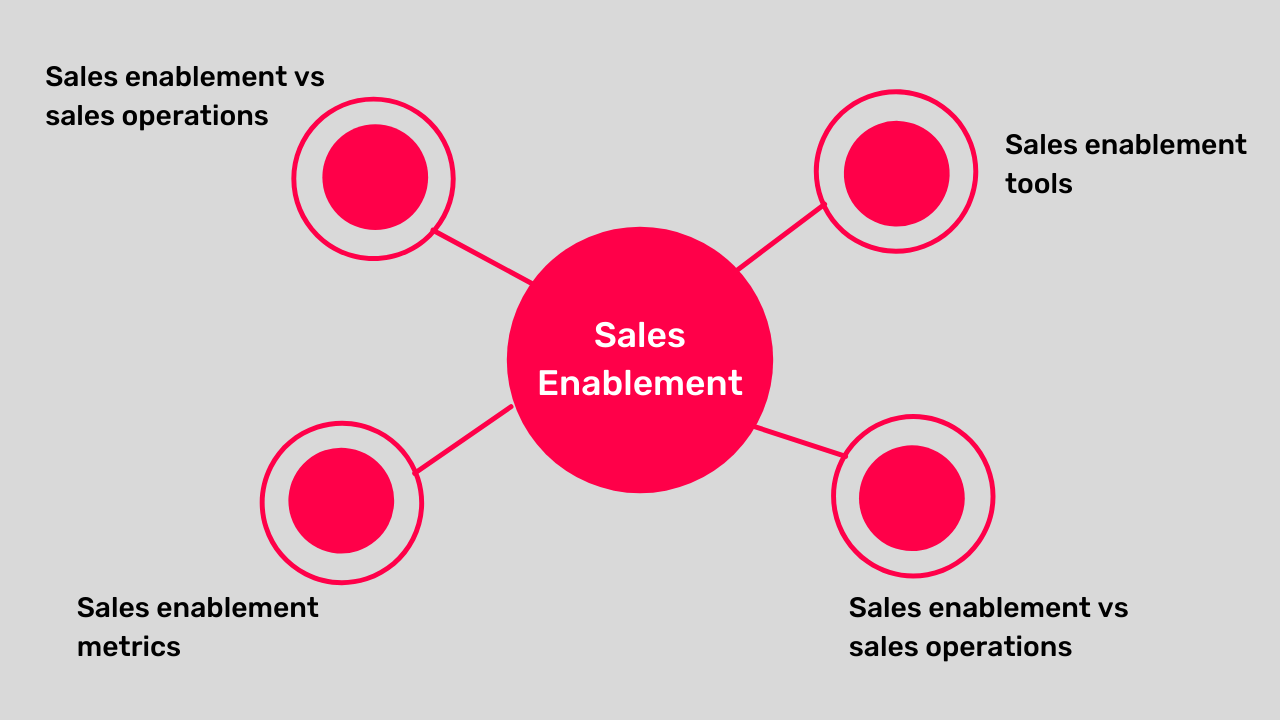

The more coverage via content you get around the main subject of your topic cluster, the better you’ll be able to:
- Find people with super-specific intent
- Fill all the gaps
- Rank for your broader keyword
- Dominate SERPs for that related keyword
Build your topic cluster and focus on internal linking—which leads us to the next step in the strategy.
Key takeaways:
- Organize your content into topic clusters to build a structured, authoritative site architecture.
- Develop pillar pages that provide comprehensive overviews of your main topics.
- Link sub-topics back to your pillar page to distribute page authority and improve search rankings.
6. Super-charge your internal linking in your B2B content
Internal linking is just as important as external linking.
An internal link is any link from one page on your website to another page on your website. It helps both your website visitors and crawl bots better navigate your website. It also helps Google understand the structure and hierarchy of your website.
Everyone makes such a big deal about building backlinks. Yes, backlinks are important, but not to the detriment of internal linking!
If you don’t have a system for internal linking, your topic cluster and topical relevance efforts will fall flat.
Content-led, systematic internal linking will move the needle for your B2B SEO strategy.
But it doesn’t need to be complicated. Here’s how you can do it:
Keep a spreadsheet of all the content you have in each category/topic cluster
You can even use your content editorial calendar for this. Make sure you write down the category it belongs to. If you’re outsourcing writing, include possible anchor texts the writer can use.
Add links to old related content with every new piece
Every time you write a new piece, link back to an older piece from within the same category. Keep links to money pages (feature pages, pillar pages, BOFU content) as high up in the post as possible.
Once published, go to older posts and add links to new content
Don’t only add links to old content onto new content. Either once you publish a new piece or once a month, go back and add links to your new content into your old content from the same category.
Key takeaways:
- Internal linking strengthens your SEO by highlighting relationships between content and improving site navigation.
- Develop a systematic approach to internal linking that enhances both user experience and SEO.
- Regularly review and update your internal links to maintain a healthy and effective site structure.
7. Reoptimize your existing pages
This is more of a quick win if you already have a lot of content.
There are three reasons you might want to reoptimize content:
- Content decay
You have content that used to perform well, but for whatever reason it’s fallen in rankings over the last few months. Maybe it’s outdated, or maybe the search intent has changed. Or maybe it’s suddenly become a lot more competitive.
- Newly published content
If you published something in the last 3-6 months, it’s worth going back into GSC to check what keywords it ranked for. This is a vital part of on-page SEO—ongoing optimization of your existing content.
Generally new content won’t immediately get to the top 3, so you’ll want to keep an eye on it.
- High-traffic pages that don’t convert well
This may be a topic play—some topics just don’t lend well to higher conversions, but sometimes they can be improved.
I’ve seen plenty of B2B businesses build a blog with no CTAs at all, or only some at the bottom.
You can conversion rate optimize your pages that should be converting but aren’t.
Sometimes it’s just about adapting the CTA to the actual search intent rather than a generic CTA.
This is one of the most vital low-hanging fruits you can do to supercharge your B2B SEO strategy.
Key takeaways:
- Regularly update and optimize existing content to prevent decay and maintain rankings.
- Use analytics and Google Search Console data to inform ongoing optimizations of new and existing content.
- Optimize high-traffic but low-converting pages to improve their conversion rates through better CTA alignment and content relevance.
8. Build backlinks and digital PR for your B2B website
Link building.
The most dreaded and frustrating part of SEO.
But, as you scale, you’ll most likely need to build some links.
Other than networking, constant outreach, and investing heavily in link building, one great way to get links is to build shareable content assets, like proprietary research reports or statsitics, that you can then share with journalists.
Curating statistics or running your own proprietary study that news media might want to link back to is one of the best ways to get links to your content. Those studies aren’t content that will particularly convert into buyers, but it will drive links.
Key takeaways:
- Backlinks remain a critical factor in SEO; prioritize building quality links through creative content strategies.
- Use proprietary research, unique data, and compelling stories to attract backlinks naturally.
- Engage in digital PR efforts to get your content in front of influencers and media outlets within your industry.
The secret to success in your B2B SEO strategy
Your B2B SEO strategy will be successful if you look at it holistically. Some content is meant to convert, and other content is meant to support the converting content and help build your brand.
Brand is everything in B2B, and search engine optimized content is one of the best ways to build that brand. If you look at all parts of the funnel that need supporting and have a long-term vision, it’ll become clear what you need to do.
